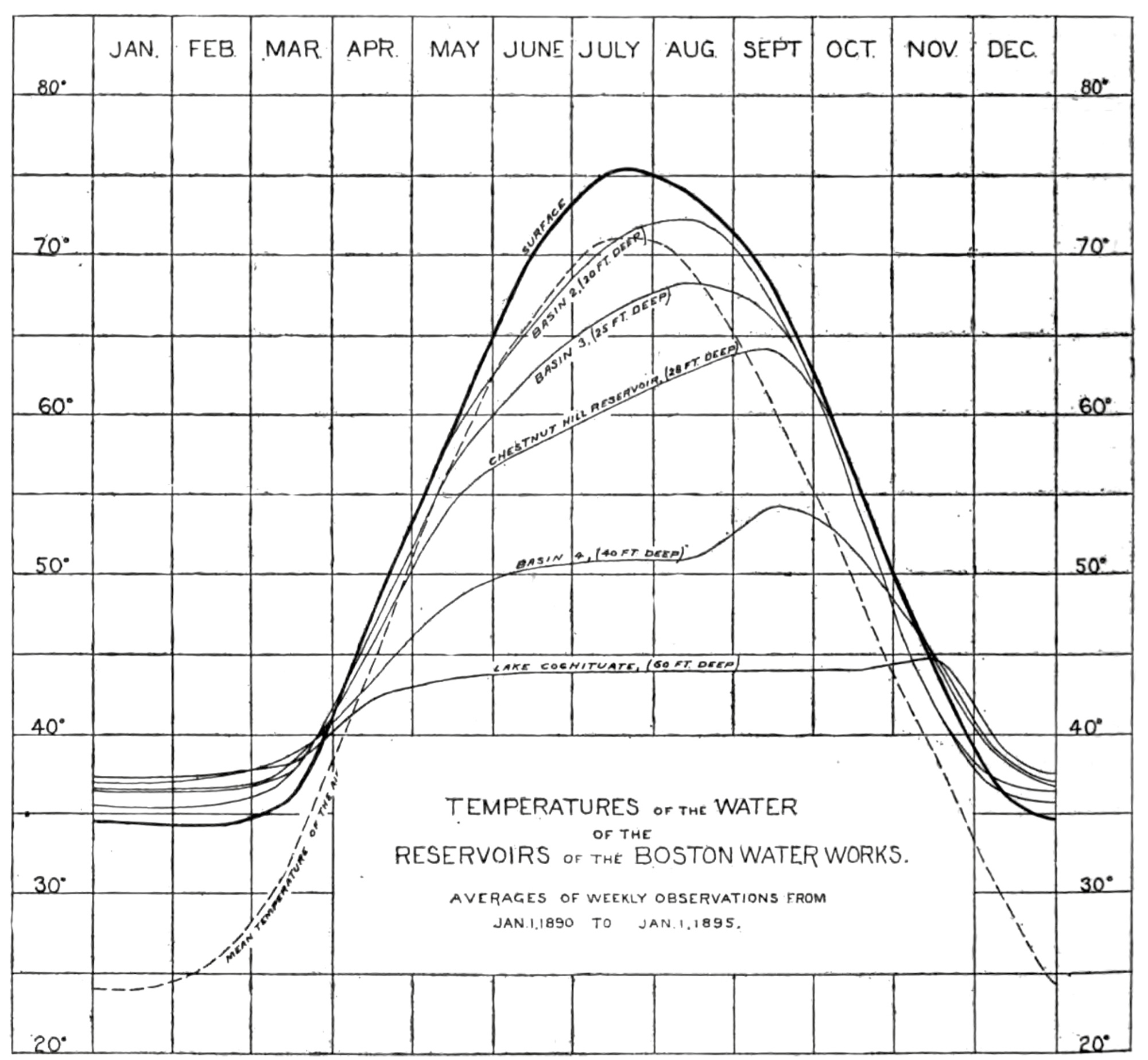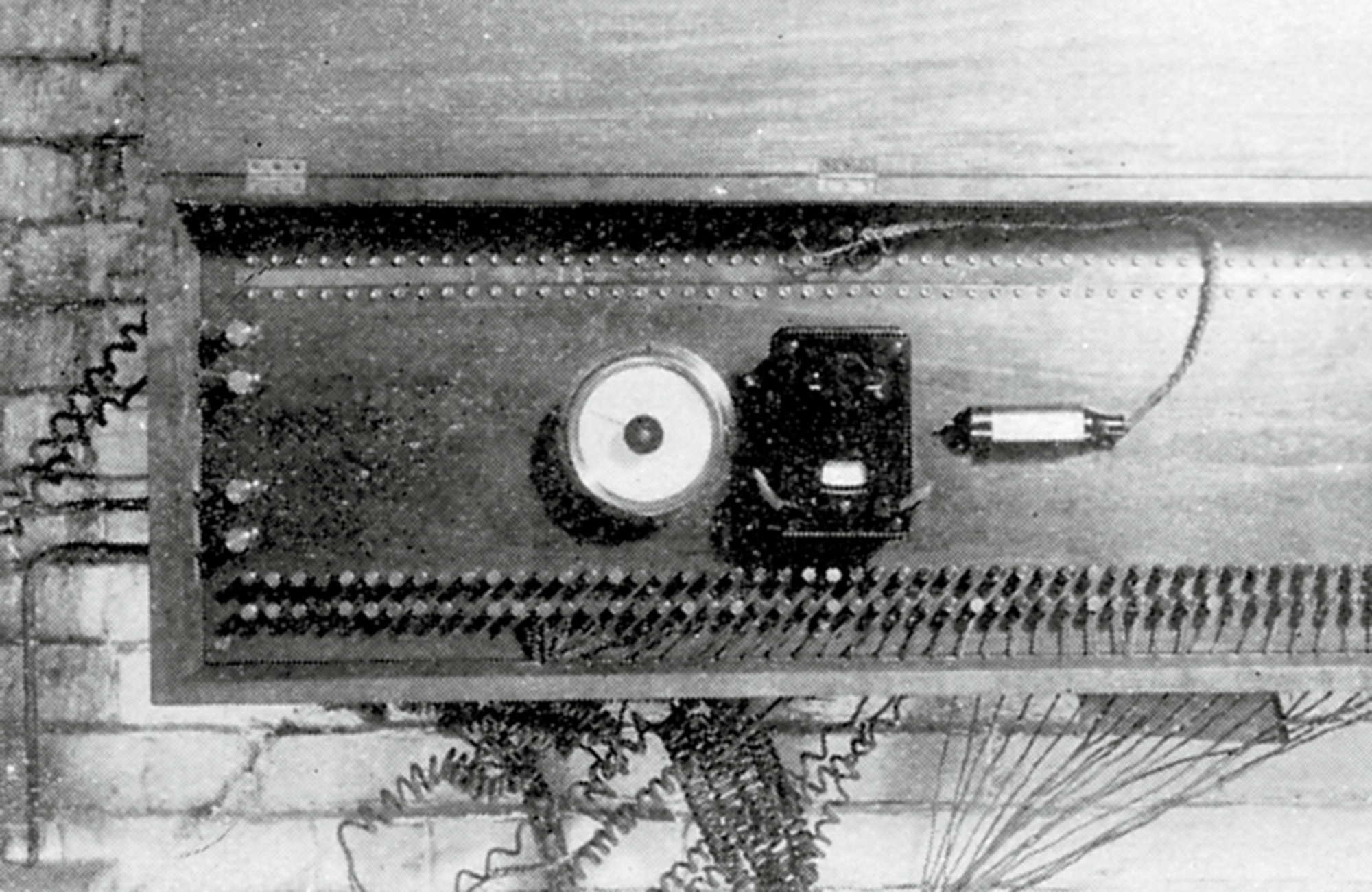Listening to the Cooler
Taking the temperature with the thermophone
Michael Osman
To obtain the value of a sound, a movement, measure from zero.
—John Cage, “2 Pages, 122 Words on Music and Dance,” 1957
The instrument is used as follows: while turning a dial, graduated to indicate the temperature in degrees Fahrenheit, the user hears a tone, a buzz from a telephone receiver. When the dial approaches a point at which the current is balanced between two leads in a coil each made from a different metal, the tone goes silent. It is at this moment, in silence, that the instrument offers a temperature reading. Tone is noise, while silence signals information.
The instrument is a thermophone, a combination of the Greek words for heat and voice. It “speaks the temperature,” translating an environmental condition into sound and then silence. Unlike musical instruments that are tuned to produce harmonic frequencies for making art, the thermophone is used for tuning into an environment by establishing an electrical harmony of zero frequency. It is a particular form of technological synesthesia, as the sense of heat becomes (in)audible.[1]
The design of the electrical circuitry for the thermophone resulted from a collaboration in the 1890s between biologist George C. Whipple of the Chestnut Hill Reservoir Biological Laboratory and inventor Henry E. Warren. They claimed that the value of the device lay in “obtaining the temperature of a distant or inaccessible place,” though it also determined temperatures with greater accuracy than could be obtained with a “mercurial thermometer.”[2] It was particularly useful for Whipple, who was employed by the Western Division of the Boston Water Works to improve the water quality in the Chestnut Hill Reservoir. To collect data about the dynamics of heat in the water, he dropped thermophone coils to varying depths in the reservoir and Lake Cochituate, another source for the city’s water supply. During his daily boat rides over the span of a year, he listened to his portable instrument as it went silent, mapping the temperatures of the deep liquid mass beneath.
This collection of measurements was made to establish a correlation between temperature and the seasonal distribution of microorganisms in the reservoir. Bostonians had grown intolerant of the putrid smells and strange colors that arrived in their drinking water as a result of these particular forms of life. In his writings, Whipple explained that the quantity of food, constituted by a particular congregation of lake algae, was directly related to the survival of these pests. His theory traced an indirect relationship between water temperature and population growth. Putting the temperatures of every point in the lake at every moment in a year on the record was a form of medical inspection that Whipple performed on a sick body, or more precisely, on a sick body of water. The specific locations of infections and the patterns of their appearance through the year offered the Boston Water Works a map for regulating the risky growth of unwanted life in the reservoir.[3]
The thermophone was not solely used below water; it was also used to make measurements of temperature within the inaccessible recesses of buildings. One such instrument was hung in the Massachusetts State House. But it was the installation in Boston’s Quincy Market Cold Storage Warehouse in 1897 that made the headlines of a leading cold storage trade journal. For a line of business that depended on being able to guarantee a desired interior temperature to its customers, the thermophone seemed to be an eminently useful technology. The journal Ice and Refrigeration described the value of Warren and Whipple’s apparatus for the purposes of cold storage:
We illustrate herewith the recently invented Thermophone, an instrument which seems to come into general use in large modern refrigerating plants. For a long time there has been a call for some form of apparatus, which should enable the engineer or manager of a cold storage warehouse to instantly inform himself of the temperature of individual rooms or of circulating pipes and ducts in distant or inaccessible parts of the building.
To control the temperature in its storerooms, the Boston storage company circulated cooled brine through a network of pipes in the wall cavities of all its warehouse buildings in the market district. Given the long distances between the manager and his storerooms, the installation at the Quincy Market Cold Storage Company needed to be far more complex than the simple mobile instrument that Whipple used to collect his data from a lake or reservoir. This industrial thermophone was made up of forty sensitive coils situated in the company’s storerooms. Each coil was linked back to a brass button located on a switchboard that hung beside an ammonia compression engine in a warehouse on Richmond Street. By bringing a small rubber handle attached to a graduated dial into contact with a button, the manager linked the dial to a sensing coil that was located in a distant storeroom. The switchboard could contain as many as one hundred such connections, all gathered within a man’s reach, thus bringing together “the temperature of air ducts in the seventh story of the building, of pipes under floors and on high ceilings, and of others in deep and dark brine tanks.”[4]

The thermophone was like a stethoscope for a building, offering auditory access into its cavities. Unlike the stethoscope, however, the instrument did not extend the distance between the inner organs and the inspecting ear, but collapsed the space between the manager and his facility using the impulse of an electrical signal. Through a small grid of electrical leads, it centralized data collection from these disparate locations. Once he was trained to hear the value of silence as a datum of temperature from distant places, the manager could carefully correct the delivery of cooled brine at each point in the network of storage space where changes were constant and the danger of spoilage imminent.
If the water at Chestnut Hill was a reserve for the life of the city’s inhabitants, the perishables preserved in cold storage served as a reserve for the life of the economy. Large quantities of produce were held in these warehouses to establish a speculative futures market in perishables. Concentrated orange juice, pork bellies, butter, and eggs were just a few of the numerous commodities that were available for speculation after their perishability had been temporarily suspended. To be properly preserved meant that onions stored in a given warehouse, for example, should neither be allowed to freeze nor sprout. If either event would occur, the value of those onion bushels would be irredeemably destroyed. In matters of preservation, even a few degrees of inaccuracy could be the cause of massive spoilage. Developing technology for keeping the foods held in storage fresh was motivated by the need to preserve their value for exchange on the market.
As the Quincy Market Cold Storage Company expanded its network of temperature-controlled storage space in Boston, it became a public utility comparable to the Boston Water Works and was regulated by the state’s hygienic laws. The quantities of food held in these storerooms had become a tool for stabilizing the prices of commodities. Therefore it was not enough to install a cooled-brine pipe in each storeroom and maintain it regularly while overseeing its operation with a thermophone; economic control was formalized through the power of legal statutes that set the degree of acceptable deviation in temperature and price that would be allowed for each commodity.

From water works to cold storage, the thermophone lent itself to two forms of regulation: one that produced data to predict pathological patterns and another that relayed data of error for instantaneous correction. The institutional drift of this unique instrument from one context to another reveals the breadth of the territory on which “the managerial revolution” was played out.[5] The value of such technically enhanced forms of perception had been elaborated by Friedrich Nietzsche, who used the metaphor of altered vision rather than sound: “It is the value of all morbid states that they show us under a magnifying glass certain states that are normal—but not easily visible when normal.”[6]
The instruments of modern life are constantly communicating. While much of this communication takes the form of sound, the thermophone demonstrated that becoming aware of silence could be an equally important form of environmental perception in the regulatory logistics of management. By entering into the sensory circuitry of the thermophone, a well-trained listener established himself as one element within the proliferation of feedback systems that managed the risks endemic to modernization.
- Henry E. Warren and George C. Whipple, “The Thermophone, A New Instrument for Determining Temperatures,” Technology Quarterly, vol. 8, no. 2 (July 1895), p. 152. The patent is “Electrical Thermometer,” no. 540,008 (28 May 1895).
- George C. Whipple, “The Thermophone,” Science, New Series, vol. 2, no. 46 (15 November 1895), pp. 639–643. Warren would go on to invent the first synchronous electric clock. The device was produced by his company Telechron, another amalgam of two Greek words—here distance and time were brought together in an instrument that related timekeeping to the transmission of electricity.
- George C. Whipple, “Some Observations on the Temperature of Surface Waters; and the Effect of Temperature on the Growth of Micro-Organisms,” Journal of the New England Water Works Association, vol. 9, no. 4 (June 1895), pp. 202–210.
- “The Thermophone Installation at the Quincy Market Cold Storage Co.,” Ice and Refrigeration, vol. 12 (January 1897), p. 34.
- Alfred Chandler, The Visible Hand: The Managerial Revolution in American Business (Cambridge, MA: The Belknap Press of Harvard University Press, 1977).
- Friedrich Nietzsche, The Will to Power, trans. Walter Kaufmann and R. J. Hollingdale (New York: Vintage Books, 1968), p. 29.
Michael Osman teaches architectural history and theory at the University of California, Los Angeles. His recent essays include “The Managerial Aesthetics of Concrete” in Perspecta no. 45 on “Agency” (2012) and “Architecture Ad Absurdum” in Log no. 22 on “The Absurd” (Spring/Summer 2012).
Spotted an error? Email us at corrections at cabinetmagazine dot org.
If you’ve enjoyed the free articles that we offer on our site, please consider subscribing to our nonprofit magazine. You get twelve online issues and unlimited access to all our archives.